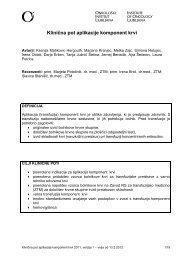Create successful ePaper yourself
Turn your PDF publications into a flip-book with our unique Google optimized e-Paper software.
Involvement of the lysosmal cysteine peptidase Cathepsin<br />
L in progression of epidermal carcinomas<br />
Tobias Lohmüller, Julia Dennemärker, Ulrike Reif, Susanne Dollwet-Mack,<br />
Christoph Peters and Thomas Reinheckel<br />
Department of Molecular Medicine and Cell Research, Albert-Ludwigs-University Freiburg,<br />
Germany<br />
Papain-like cysteine proteases have been implicated to work as effectors of<br />
invasive growth and neovascularisation. In order to assess the functional<br />
significance of cathepsin L (CTSL) during neoplastic progression in a transgenic<br />
mice model of multistage epidermal carcinogenesis, we adopted a<br />
genetic approach utilizing cathepsin L-knockout mice breed with transgenic<br />
Tg(K14-HPV16) mice, which express the human papillomavirus type 16 oncogenes<br />
under the control of the human keratin 14 promoter, and reproducibly show multistage<br />
development of invasive squamous cell carcinomas of the epidermis [1]. Before the<br />
intercross of the two mouse lines, CTSL-deficient mice have been backcrossed to<br />
the FVB/n genetic background for 8 generations to ensure a congenic tumor model<br />
Tg(K14-HPV16);ctsl -/- . To analyse cathepsin expression in the tumor model we quantified<br />
mRNA expression mRNA expression of cathepsins B, L, H, D, and X at various stages<br />
of tumorigenesis by real time PCR. While CTSL was absent in Tg(K14-HPV16);ctsl -/-<br />
mice, no other genotype specific differences could be observed for comparison of<br />
Tg(K14-HPV16);ctsl +/+ and Tg(K14-HPV16);ctsl -/- mice. Immunohistochemistry (IHC)<br />
revealed that CTSL lost its strong suprabasal epidermal staining during carcinogenesis<br />
was uniformly distributed in cancers, while CTSB maintained its staining pattern.<br />
Interestingly, IHC quantification of the proliferation marker Ki67 showed significant<br />
higher proliferation rates in epidermis of 16 and 24 weeks old Tg(K14-HPV16);ctsl -/-<br />
mice. Further, the progression from hyperplasia to dysplasia occurs significantly faster<br />
in tumor mice with CTSL-deficiency. However, no general differences in keratinocyte<br />
differentiation, as assessed by cytokeratin 5 and 10 IHC, and in angiogenesis, as<br />
quantified by CD31-IHC and FACS analyses, could be detected. Compared to<br />
K14-HPV16 mice that are heterozygous or wild-type for CTSL, analysis of<br />
CTSL-deficient tumor mice demonstrated significant differences in squamous cell<br />
carcinoma onset and development to a tumor volume of 1cm 3 . The mean onset of<br />
the first palpable tumors in ctsl -/- , ctsl +/- and ctsl +/+ K14-HPV16 animals were at 28, 36<br />
and 37 weeks of age, and the mean age for occurrence of a 1cm 3 tumor was at 32, 43<br />
and 42 weeks, respectively. In addition, tumors of CTSL knockout mice developed<br />
significantly higher grade (i.e. less differentiated) carcinomas than wild-type and<br />
heterozygous controls. Further, the number of lymph node metastases significantly<br />
increased in Tg(K14-HPV16);ctsl -/- mice.<br />
Taken together, CTSL deficiency promotes multistage carcinogenesis in K14 HPV16<br />
mice, results in highly dedifferentiated cancers and an increased metastatic capacity.<br />
94p22<br />
[1] Coussens, L.M., D. Hanahan, and J.M. Arbeit. 1996. Genetic predisposition and<br />
parameters of malignant progression in K14-HPV16 transgenic mice. Am J Pathol.<br />
149:1899-917.

















